

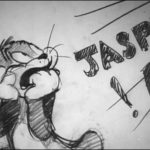

In June of 1937 after facing budget issues with their third-party cartoon producers Hugh Harman and Rudy Ising on their series of Happy Harmonies, MGM decided they were ready to start their own cartoon studio. Unfortunately, it was a fiasco, trying to adapt Rudolph Dirks’ The Captain and the Kids as an attempt to recapture the success Fleischer had with Popeye, but it didn’t jell. Attempts at trying to spice up the product with Milt Gross and Henry Hirschfield didn’t help either, leaving many productions started but unfinished in their wake. It didn’t help that audiences were not interested in these cheaper Black and White cartoons, after years of Technicolor Magic in the Happy Harmonies.
After a disastrous first year of production, Hugh Harman and Rudy Ising were brought back on as lot producers to supervise a series of high-budget cartoons to compete with Walt Disney’s lavish productions and the irreverent humor of Leon Schlesinger’s color Merrie Melodies that were growing in popularity. The MGM studio was finally settling in a more stable form, and it was during this period of the studio’s existence many people would join the studio or leave. Director Friz Freleng grew dissatisfied with the everchanging policies and politics of Metro’s cartoon studio and jumped back to his safe haven at Schlesinger’s Termite Terrace in the spring of 1939, following completion of The Mad Maestro and The Bookworm under Hugh Harman.
This left an opening for a director position under the supervision of one of the producers to supplement the releases. On August 12, 1939, The Hollywood Reporter announced in a blurb that William Hanna, who directed alongside Freleng on the earlier Captain and the Kids at Metro, was selected as a co-director under Rudy Ising. Then, Joseph Barbera, a storyman who played a hand in the studio’s political maneuvers, was promoted to Hanna’s co-director under Ising’s supervision. While the Hollywood Reporter indicates the unit would only make musical cartoons, it appears the true intention was for Bill and Joe to emulate the Schlesinger cartoons by producing cartoons with more humor and rowdiness compared to Harman and Ising’s typically gentle output.
Hanna and Barbera were seemingly allotted to do any story they wanted for their first cartoon. Barbera chose a cat-and-mouse story, perhaps a safe haven from his days at Terrytoons, although the idea was perceived as hackneyed and retrograde within the studio.
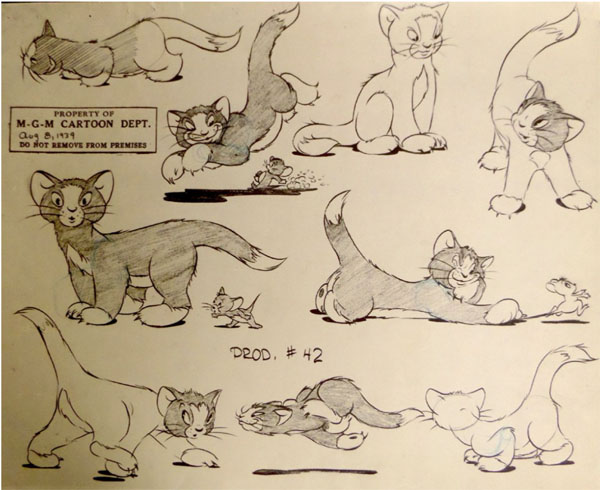
Model Sheet by Bob Allen for Bill and Joe’s Cat and Mouse Cartoon.
The cartoon, which became 1940’s Puss Gets the Boot, sees a housecat named Jasper in control of a mouse he intends to eat, but remains playful with it. That is, until the Mouse pokes Jasper in the eye, which leads to a chase that breaks a vase. The Maid of the House (voiced by radio talent Lillian Randolph) threatens to throw out Jasper if anything else is broken. Now, the Mouse takes control of the dynamic, attempting to break the glassware and the dinner plates to frame The Cat. Finally, a large tower of dishes lands and shatters on the floor. The Cat receives the blame and gets the boot for good, just as the title dictates.
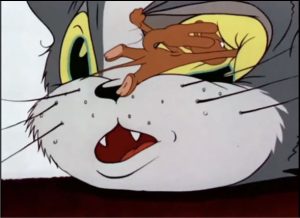
“Ouch!”
As noted before, the Cat in this cartoon is named Jasper. The Mouse however remains nameless on screen, and despite legends of being given the name Jinx, there is no period documentation that gives him this name. In fact, Joe Barbera notes in his book My Life in Toons that this Mouse did not have a name, which is supported by a lack of names in surviving artwork and the studio copyright. The only period name for this character was in MGM’s Short Story Magazine, used to promote Metro’s short subjects. In the January-February 1940 issue, the description for Puss Gets the Boot labels the Mouse as Pee Wee, and while the only example of this name’s usage, is the closest to the duo having any official name.

Click To Enlarge
After production of Puss Gets the Boot, despite internal interest in doing more with the pair, Quimby ordered Bill and Joe to create more miscellaneous cartoons such as Swing Social, Gallopin’ Gals, and The Goose Goes South. The first was a return to black music that hadn’t been seen since the Singing Frog cartoons of the Happy Harmonies, and the latter two were primarily in the mold of Tex Avery’s spotgag/documentary parody cartoons that gained a lot of traction in 1939, with Detouring America being nominated for the Academy Award. Joe remembered later in life being dissatisfied making these cartoons, later calling them “horrible” and “turkeys”. In truth, these cartoons lack characterization as appealing and thorough as Jasper and Pee Wee, and the non-storytelling approach did not mesh as well as Avery’s efforts.
This still left Metro with the issue they had little to offer in cartoon stardom. While the cartoons were still very successful, Metro had struggled for over a decade to maintain any cartoon stardom. Harman and Ising couldn’t materialize true marquee stars in their earlier Happy Harmonies. MGM’s only cartoon stars in 1940 were Hugh Harman’s Bear Family, but they were cast out after two releases that year; Rudy Ising’s lumbering Bear, eventually named Barney, would not become a key player to Disney’s Donald Duck and Mickey, or Schlesinger’s Porky Pig and the newly introduced Bugs Bunny. Thankfully, Hanna and Barbera would not be stuck on these cartoons much longer.
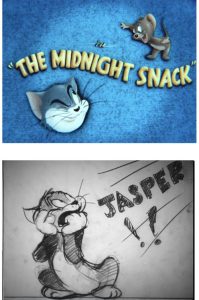 When Puss Gets the Boot was released in February 1940, it immediately gained traction critically and commercially, which allowed Hanna and Barbera to leave Ising’s supervision and gain their own separate unit. By March, Besa Short wrote to the studio inquiring about more Cat and Mouse cartoons. Besa wasn’t just another fan of the cartoon, she booked programs for nearly 200 theaters in Texas and placed a special focus on short subjects and their advertising. Naturally, a person of her reputation and eye was someone to listen to, so Quimby finally relinquished and had Bill and Joe develop a followup as MGM’s first true character series in 7 years. (As a detour, click here to learn more about Miss Besa Short)
When Puss Gets the Boot was released in February 1940, it immediately gained traction critically and commercially, which allowed Hanna and Barbera to leave Ising’s supervision and gain their own separate unit. By March, Besa Short wrote to the studio inquiring about more Cat and Mouse cartoons. Besa wasn’t just another fan of the cartoon, she booked programs for nearly 200 theaters in Texas and placed a special focus on short subjects and their advertising. Naturally, a person of her reputation and eye was someone to listen to, so Quimby finally relinquished and had Bill and Joe develop a followup as MGM’s first true character series in 7 years. (As a detour, click here to learn more about Miss Besa Short)
This next cartoon, named The Midnight Snack, streamlined and improved the dynamic in Puss in ways that allowed for longevity. Barbera was wise to remove the predator-prey instinct and change into something more of a playful rivalry, where the Mouse fails to obtain cheese without being caught, with Jasper using the Mouse as a frame to obtain food himself. After a chase, the Mouse gets his revenge and gets Tom blamed for more destruction of the house.
Both designs were streamlined, especially in The Cat, which helped better convey the comedy on screen, as well as Scott Bradley’s playful scores, using Sing Before Breakfast (from MGM’s Broadway Melody of 1936) when Tom makes way into the icebox. But the most significant change to audiences would be the names, from Jasper the Cat and the Mouse, to Tom and Jerry. The common story, and the one Barbera claims in his book, was that this was pulled out of a hat with that specific suggestion being from animator Jack Carr, which seeming logical, does not appear to be the case.
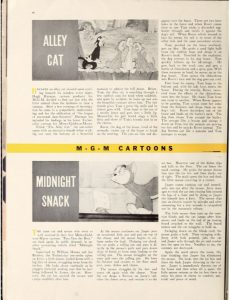
Click To Enlarge
The earliest mention of a name change to Tom is from November 1st 1940, with a separate model sheet that same day with the previous Jasper name. As for why the name Jerry, I suspect Metro initially wanted a Mickey Mouse naming style, but someone reconsidered and requested a new name for the Cat in return. Tom seems an obvious choice because of “Tom Cat,” but he wouldn’t have been the only one at MGM during this period. While The Midnight Snack was in production, Hugh Harman produced and directed The Alley Cat, which introduced a cat that would later be paired as a Tom and Jerry character, Butch. However, in the MGM Short Story blurb for Midnight Snack, Jasper is named Tom, the same name on his October 3rd, 1940 model sheet. Whether or not they directly borrowed the name from this character remains unclear, but it’s possible to consider.

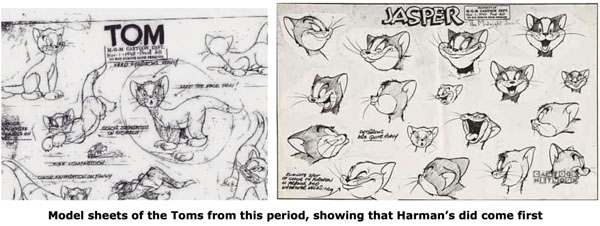
Joe Barbera would admit decades later the names were “unoriginal”, which was certainly true. Joe maintained they were named after a popular drink that was named after a duo in an 19th century novel, but there were earlier screen uses of the name. Readers may be familiar with Van Beuren’s Tom and Jerry cartoons, but it should be noted Barbera did not work on this series but was likely aware of the duo as he began in animation when Burt Gillett was running the Van Beuren studio into the ground. And before the cartoons, there were separate live action (in 1916) and stop motion series (in 1924) during the silent era with the Tom and Jerry name, and while not the biggest films of the world, they did exist. In MGM’s own The Captain’s Christmas, when John Silver sings to try and get money for new toys, one is his lines is “Tom and Jerry half-and-half/Drink it down and laugh and laugh”, showing clear familiarity with the name and giving credence to that being why Tom was chosen as the name beyond Tom Cat.

It should be noted that Tom and Jerry, beyond those earlier pairups, were already associated with a cartoon Cat and Mouse in minor uses. In Paul Terry’s Fable of The Two Explorers from 1922, copyright and publicity establish that the stars are Tom Cat and Jerry Mouse. Additionally in 1931, in Oswald the Rabbit’s Country School, we hear during the Teacher’s roll call for two students named Tommy Cat and Jerry Mouse in succession. As for whether there was a pre-established media that popularized calling mice Jerry and paired with a Tommy Cat remains unclear, but it’s intriguing nonetheless.
Returning to Bill and Joe, they would make one more miscellaneous cartoon, Officer Pooch, before almost exclusively turning out Tom and Jerry cartoons for the next 15 years. The characters would continue to evolve and develop, eventually becoming the most beloved Cat and Mouse cartoon. Tom and Jerry would go on, but the story I’ve told ends here, not bad at all for where Jasper and Pee-Wee first began.
(Big Thanks to Devon Baxter, David Gerstein, Kamden Spies, Zoran Sinobad, & Don Yowp)